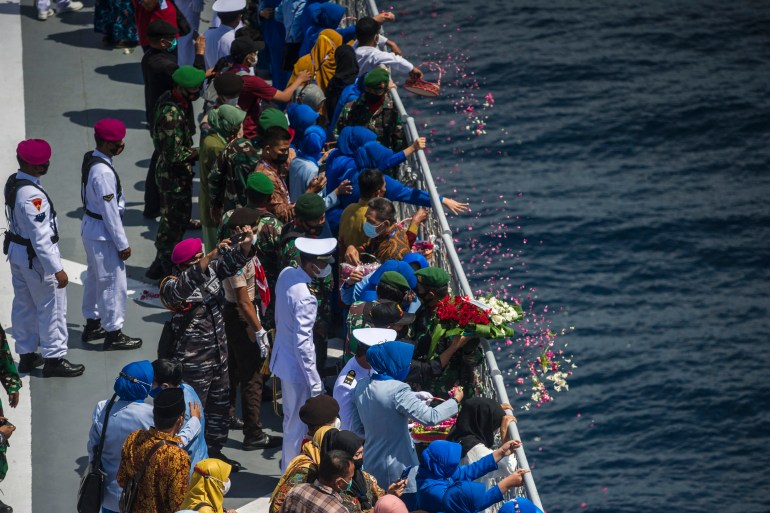Indonesia’s submarine sinking highlights military’s shortfalls
The archipelago’s armed forces began a modernisation programme in 2007, but face increasing maritime challenges.

Surabaya, Indonesia – As Indonesian authorities announced this week that a salvage operation involving Chinese underwater rescue vessels had managed to recover “debris” from the KRI Nanggala-402 submarine, which sank off the coast of Bali last month, questions have been raised about the state of the country’s military and its operational readiness.
Rescuers have so far been unable to locate the main body of the stricken vessel which sank on April 21 while conducting live-fire torpedo exercises.
Keep reading
list of 4 items‘My heart is broken’: Families mourn lost Indonesian crew
Hopes fade for Indonesia submarine crew as oxygen dwindles
Facing ‘morale blow’, Indonesia steps up search for submarine
It is thought that the submarine – with 53 crew on board – suffered a mechanical failure and sank to a depth of more than 840 metres (2,755 feet), well below its crush depth of 300 metres (984 feet), causing it to break into three pieces.
Speaking to the media on Tuesday, Rear Admiral Iwan Isnurwanto said that items from the KRI Nanggala-402 have been recovered including torpedo cables, technical manuals, life rafts and metal plates from the outside of the vessel but that the salvage operation had yet to locate the main body of the ship.
He added that raising any parts of the submarine would be a difficult task.
“Several times, the Tan Suo-2 [a Chinese rescue vessel] has tried to lift the bow or the bridge. They estimate that the main platform weighs approximately 18 tonnes, so it turns out they were unable to lift it […]” he said.

An underwater crater filled with mud has also been discovered by the search teams, and Isnurwanto said that it was possible that the main section of the submarine was lodged in the crater, along with the bodies of the crewmen.
The sinking of the KRI Nanggala-402, which was built in 1977 in Germany and bought by the Indonesian Navy in 1981, has prompted questions about the overall quality of Indonesia’s defence equipment, most of which is sourced from abroad.
Modernisation programme
Over the years, Indonesia has imported military equipment from more than 20 countries including the United Kingdom, the United States, Russia and South Korea.
Indonesia began to modernise its equipment in 2007.
Gilang Kembara of the Centre for Strategic and International Studies (CSIS), an Indonesian think-tank that focuses on strategic, political, security and economic affairs, says the Indonesian Navy launched its Minimum Essential Force Strategy in 2010 with a view to updating and upgrading its equipment by 2024.
“The Navy is modernising its warships, which is being done out of consideration for the number of very old warships in use in the fleet, many of which were made during the Cold War,” he told Al Jazeera. “It is also concentrating on rejuvenating its defence equipment on submarines, frigates, and aircraft and helicopters for the Navy’s Aviation Centre”.
In 2021, the budget for the Indonesian Armed Forces was increased by 11 percent to 136 trillion Indonesian rupiah ($9.2b), following budget cuts in 2020 due to the COVID-19 outbreak.
At the time the KRI Nanggala-402 sank, the Indonesian Navy had ordered three additional submarines from South Korea, with the aim of operating a fleet of eight submarines by 2024. The KRI Cakra-401, the sister submarine of the KRI Nanggala-402, has been undergoing essential maintenance since January 2021.

Made up of more than 17,000 islands, Indonesia is facing a growing number of maritime challenges and has found itself in disputes with China whose fishing vessels have been found operating illegally in the waters of the archipelago.
Natalie Sambhi, the executive director of Verve Research, a multidisciplinary research collective focusing on Southeast Asia’s militaries, previously told Al Jazeera that Indonesia’s submarine capabilities were “woefully inadequate” given the potential scale of its operations.
Indonesia also has a history of homegrown or civil-military programmes that are meant to complement its official Armed Forces, including the Bela Negara concept, which seeks to involve civil society directly in the greater project of national defence, through paramilitary training, ideological education and the establishment of auxiliary reserve troops.
But Ian Wilson, a senior lecturer in politics and security studies at Australia’s Murdoch University, says this focus could have left the armed forces ill-prepared for the challenges they now face.
“In many respects, this conflicts with the idea of a professionalised, modern and well-resourced military focused on the protection and defence of Indonesian territorial sovereignty and national interest, from potential external sovereign threats,” he said.
“Historically the military has been primarily an institution focused on internal control and power, and this is perhaps one explanation as to why it has, despite this centrality, been under-resourced in terms of modernising equipment.”
‘Legendary ship’
The Indonesian Armed Forces was founded in October 1945 following independence and currently has about 400,000 personnel across the navy, army and air force.
Despite the challenges – and allegations of human rights abuses in some areas where it operates – for many in the country, a life in the military is considered a competitive and illustrious career.
Rear Admiral Frans Wuwung was once the chief engineman of the KRI Nanggala-402, and says he felt nothing but pride when when he worked on the ship from 1981 to 1985.

Wuwung says the submarine’s crew would have had to go through a rigorous training and selection process before being allowed to work on the vessel.
“The submarine was such a huge part of my life and my life experience. They can’t be separated,” he said. “I haven’t stopped crying, to be honest, since it went missing.
“It’s like the memories of my youth have sunk with it. And, even more heartbreaking, my younger brothers, the best people of this nation, had to die along with this legendary ship.”